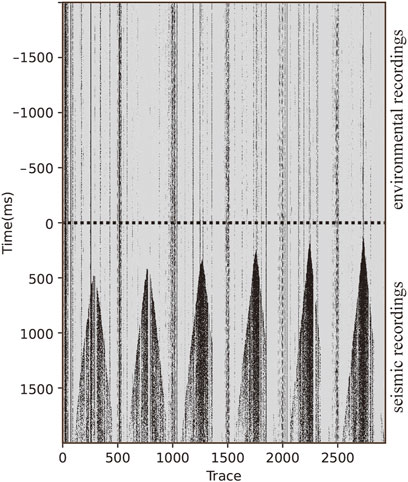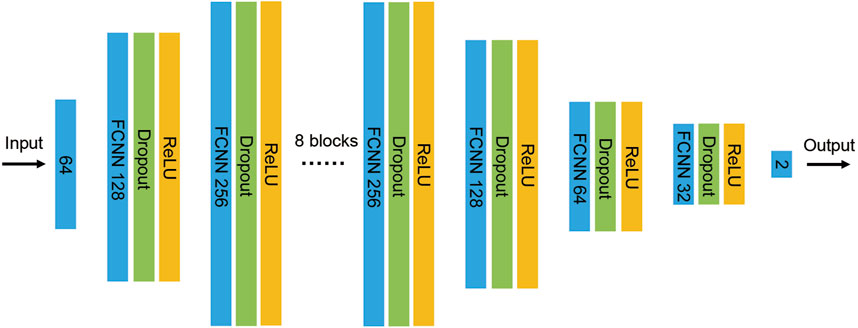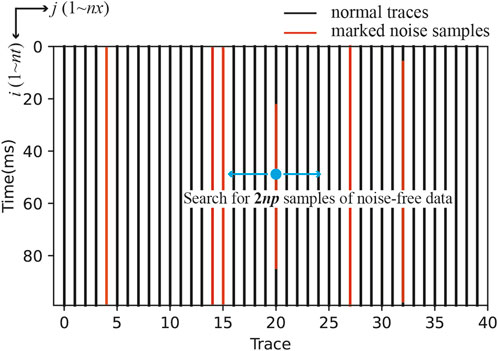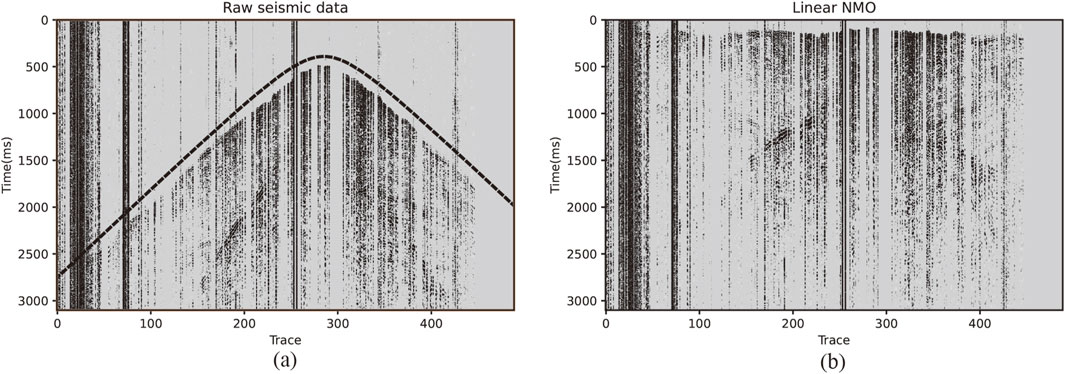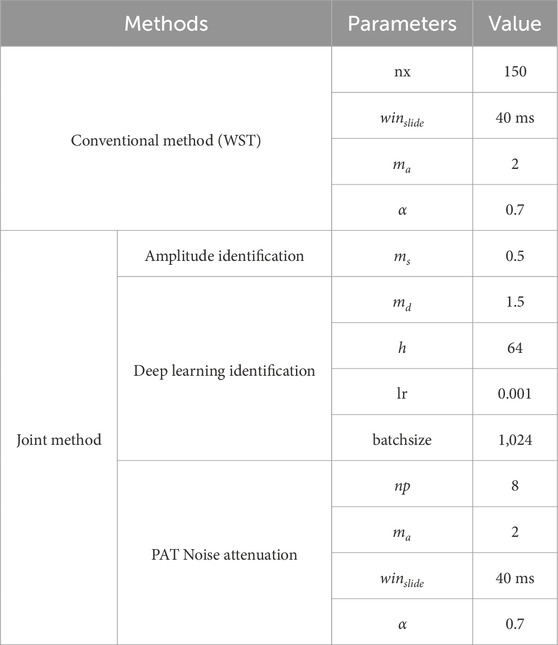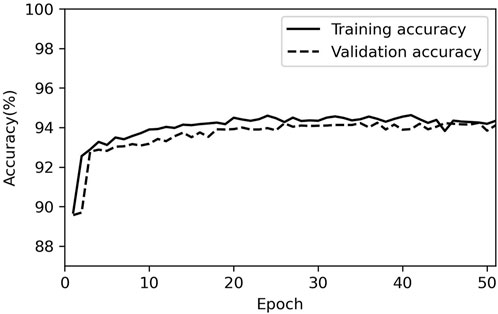- 1PetroChina Xinjiang Oilfield Company, Karamay, China
- 2BGP Inc. China National Petroleum Co., Zhuozhou, China
- 3Shale Gas Research Institute, PetroChina Southwest Oil & Gas Field Company, Chengdu, China
Seismic data acquisition inevitably faces disruptions from various environmental sources, such as factories, machinery, and highways. These disturbances introduce anomalous amplitudes in seismic data, significantly compromising the signal-to-noise ratio (SNR). At present, the primary approach for denoising such noise involves direct attenuation when amplitudes surpass a predefined threshold. However, determining this threshold relies on the window size of the selected data. Small windows are unable to suppress continuous anomalous noise traces, while using larger windows to calculate thresholds results in inaccurate outcomes. Furthermore, the window-based threshold computation can inadvertently damage non-noise strong amplitude signals, like near-offset traces or surface waves. In this study, we take advantage of the distinctive characteristics of seismic data acquired by nodal instruments. These instruments not only record seismic data but also preserve pure environmental signals which are recorded ahead of the shooting time. Combining the statistical distribution of the amplitudes of pure environmental signals and deep learning techniques, we identify data samples potentially contaminated by anomalous amplitude noise in the seismic data. Based on noise identification, we propose a novel pointwise adaptive threshold (PAT) method. This entails calculating an individual threshold value for each noise sample and subsequently applying noise attenuation. The proposed method offers several benefits, including more accurate threshold computation, preservation of effective signals with strong amplitudes, reducing the dependence on picking precise first-break, and simultaneously addressing multi-trace and single-trace anomalous amplitudes. Moreover, this approach has high robustness, as misidentification in local sample points does not influence the outcomes of noise attenuation.
1 Introduction
During the acquisition of seismic data, it is inevitable that geophones will also record environmental vibrations, such as machinery, highways, railways, factories, pedestrians, etc. These external factors can introduce noise with anomalous amplitude into the seismic data. This noise belongs to non-coherent noise and has the characteristics of strong amplitude and wide frequency band. As anomalous environmental noise has much larger energy than the seismic signal, the signal-to-noise ratio (SNR) of these anomalous traces is extremely low. The noise traces with poor SNR will corrupt the seismograms and consequently affect the subsequent seismic processing (Anderson and McMechan, 1989).
Compared with random or coherent noise, anomalous environmental noise can greatly deteriorate the data and is often difficult to remove. So far, the commonly used approach is first to scan the data and locate the noise as signals with amplitudes exceeding a predefined threshold (Anderson and McMechan, 1989). When the noise is identified, it is usually directly removed or attenuated with a suppression coefficient because this type of noise dominates in the data of low SNR. The threshold for noise is typically determined by statistically averaging the trace amplitudes along the sample points in a time window. Any amplitude in the window greater than the threshold will be identified as noise and then attenuated. Similarly, the identification and attenuation of noise can also be processed in the frequency domain, where the same attenuation procedures are applied in different frequency bands (Guo and Lin, 2003). This approach is effective for noise with dominant components at specific frequencies. These methods are referred to as the window-based statistical (WST) methods. Besides, median filtering, as a statistical method, can also be used to detect and attenuate abnormal amplitudes (Liu et al., 2009; Hu and Lu, 2014; Jun et al., 2016). However, median filtering cannot denoise the continuous noise traces. Noise identification first requires the calculation of a reference amplitude which can be the absolute mean value, root mean square amplitude, maximum absolute amplitude, or other measures. The threshold is usually a multiple of reference amplitudes. Bekara et al. (2008), Bekara and van der Baan (2010) proposed an automatic threshold detection technique to speed up the identification of abnormal noise. This method avoids the adjustment of the threshold at high frequencies in different data regions. Wu et al. (2017) proposed an exponential attenuation function based on wave propagation theory, which exhibits better amplitude preservation performance compared to the fractional function.
For attenuating anomalous amplitude noise, the algorithms currently employed in various commercial software are similar. Both identification and attenuation rely on thresholds which are calculated by the WST method. Therefore, the size of window largely dictates the threshold value and the denoising outcome. Larger windows are suitable for continuous anomalous amplitude traces but can easily damage strong amplitude signals from non-noise sources, such as surface waves or near-offset traces with strong energy. Smaller windows provide more precise threshold values but are only suitable for local anomalous amplitudes and cannot handle continuous anomalous amplitude traces. In commercial software, it is common to determine an appropriate window size through trial and error.
The advancement of deep learning has led to the creation of various methods in recent years aimed at mitigating seismic noise (Yu et al., 2019; Dong et al., 2022; Yang et al., 2022; Liu and Ma, 2023). Tian and Lu (2021), Tian et al. (2022) used conventional anomalous amplitude attenuation methods to create a training dataset and employed deep learning to identify the noise distribution conditions in the data. Then based on the identification, an appropriate window size was determined, and conventional methods were used to remove anomalous amplitude noise. However, due to the complexity of anomalous noise characteristics, solely relying on deep learning for noise identification can lead to unstable results. For example, (Tian and Lu, 2021; Tian et al., 2022) treated certain anomalous amplitude noise as valid signals due to poor identification, which resulted in a disturbed denoising outcome. Li et al. (2024) constructed a pure deep-learning method to suppress abnormal environmental noise utilizing the characteristics of the data collected by the nodal instrument. However, it is difficult to have high-quality labels in the noise-dense case, resulting in a poor denoising effect.
The nodal land seismic acquisition system is convenient for setting up the instruments and has replaced the traditional method of cable-based reception (Dean et al., 2018). After the nodal instrumentation is deployed, it records signals all the time. Therefore, when the acquisition is completed and signals are fully collected, workers need to download, cut, and recombine data to form the conventional seismic data (Jin et al., 2021). This also means that in the nodes, not only the seismic signals after shooting are recorded, but also the environmental noise before shooting. Given the unique characteristics of nodal instruments, we propose a novel joint noise identification and attenuation method (the joint method). The noise identification integrates deep learning and environmental record analysis to identify seismic traces that may contain anomalous amplitude noise. On top of the identification, we devise a new method of threshold calculation. For each noise sample, we calculate their respective reference amplitudes. We refer to this method as the pointwise adaptive threshold (PAT). This method can achieve more stable noise attenuation and is unaffected by misidentification in local noise traces. The main objective of this research is to provide a framework for identifying and attenuating anomalous noise. Compared to the WST method, the primary advantage of the joint method lies in its ability to simultaneously handle multiple traces and local anomalous noise without damaging strong energy signals from non-noise sources. The paper is organized as follows: first, we briefly review the existing method, i.e., the WST method. Then, a joint method combined with environmental noise analysis and deep learning is proposed to mark the noise traces, and a PAT method is proposed to calculate the threshold. Finally, application to field nodal land seismic data shows that the joint method can effectively remove the anomalous noise while preserving valid signals with strong amplitudes.
2 Methods
2.1 The conventional window-based statistical method
In a set of seismic traces, when certain amplitudes within a user-defined data window exceed an amplitude threshold, they are considered anomalous amplitudes. In shot gathers, the amplitude of the first-break is relatively strong, and there is a sudden change of energy. To avoid damage the first-break, a cut-off curve is often defined in the vicinity of the first-break. Data processing is performed below the cut-off curve while preserving the data above it.
Data will be processed by dividing it into small groups of data based on a spatial window. Each group of data is defined as
2.1.1 Define cut-off curve
A first-break curve or a cut-off curve needs to be defined. Noise attenuation is applied only to the data below this curve.
2.1.2 Smooth data
Smooth the data for each trace in the time-axis direction using a time window with a length of
2.1.3 The calculation of reference amplitudes–WST method
Using the output from step (2), in the spatial-axis direction, when the number of traces in a subdata (nx) is less than 3, the reference amplitude value can be obtained by calculating the mean value of each spatial sample. When the number of traces (nx) exceeds 3, the reference amplitude value is the mean value of three adjacent points near the median point. Thus, a reference amplitude for each time sample can be calculated to form a reference amplitude trace
2.1.4 The calculation of attenuation coefficients
When the raw amplitude exceeds ma (threshold parameter) times the reference amplitude
where
2.1.5 Anomalous amplitude attenuation
The attenuation coefficient is both time- and spatial-dependent. The denoised data
2.2 Joint noise identification and attenuation method (joint method)
The existing method inherently has several drawbacks: (1) the attenuation result depends on the spatial window size nx. Continuous noise traces require a large spatial window nx, while individual abnormal trace requires a small nx. It is difficult to process all noise through a fixed window size. However, in practical applications, the whole data is often processed using a single window size. This method has the issue of incomplete attenuation of anomalous noise or potential damage to valid signals. (2) In seismic data, some non-noise signals, like surface waves or the traces near the source, also show strong amplitudes. The removal of surface waves requires more suitable methods and should not be directly attenuated.
With the advancement of seismic data acquisition, we propose a new method for identifying and attenuating anomalous environmental noise. The new method can effectively address the aforementioned shortcomings of the existing methods. The joint method consists of two steps: first identifying the location of the noise and then, attenuating the identified noise.
2.2.1 Noise identification
The noise identification fully utilizes the characteristics of the nodal instrument. Unlike traditional cable instruments, the data recording begins after the source excitation. Nodal instruments are wireless and start working once they are placed in the field. Regardless of whether there is source excitation or not, the nodal instruments will continuously record the signal. When the acquisition is completed, the field staff will download the data from the nodal instrument. This is followed by cutting the data based on the time of source excitation and the observation system to obtain common seismic profiles. In this acquisition approach, it means that the nodal instruments not only record seismic signals after the shooting time but also a considerable amount of environmental noise signals before the shooting time. An example of such data is shown in Figure 1, which can be simply obtained by keeping the additional environmental records ahead of the shooting time when cutting the data. Based on the amplitude statistics in the pure environmental records, we can more easily identify the exact noise distribution in the seismic records.
The dotted line in Figure 1 represents the shooting time. The signal above the line corresponds to the pure environmental records, while the signal below represents the seismic records. Figure 1 also shows that most of the environmental noise exists in both profiles before and after the shooting time. This feature indicates that using data before the shooting time to identify the noise traces is reasonable. However, the actual noise conditions in the field are more complex: (1) A small portion of anomalous noise may only appear before shooting time, potentially leading to the misidentification of noise-free traces as noise traces. Additionally, some traces with local anomalous noise may be incorrectly marked as noise-free traces. (2) Some anomalous noise occurs periodically or intermittently, meaning it does not exist in all time samples. Marking the entire trace in this situation can lead to over-correction of valid signals.
Due to the complexity of the field noise characteristics, two main technical issues exist at the stage of noise identification: (1) some clean traces can be marked as noise traces (Clean-to-Noise, CtoN), and (2) some noise traces can be marked as clean traces (Noise-to-Clean, NtoC). For the CtoN case, we propose the PAT method to address this issue. In the subsequent description of the noise attenuation method, we will explain the characteristics of the PAT method in detail. For the NtoC case, misidentification is usually due to anomalous amplitudes appearing only in seismic records. Therefore, we combine deep learning techniques to further identify the local anomalous noise which only appears after shooting. The specific flows for noise identification are as follows.
2.2.1.1 Amplitude statistics of environmental recordings
For the pure environmental recordings, we calculate the absolute mean value of each trace
2.2.1.2 Mark noise traces based on the amplitude statistics
A threshold parameter ms of noise traces is given. A trace is marked as a noise trace if its absolute mean value
2.2.1.3 Creating a deep learning dataset
We create training datasets based on the results from Step (2). After the operations in Step (2), most of the noise can be identified, nevertheless a few local noise might remain undetected. These local misclassifications constitute a minor fraction within the extensive dataset, thus having minimal impact on the network training.
We use pure environmental recordings to obtain the datasets of anomalous noise. All marked noise traces in the environmental recordings are reshaped to form one-dimensional datasets with h time samples (with a default number of 64). For each segment, we evaluate and choose the portions whose absolute mean value is greater than the threshold
We obtain the normal seismic traces from the seismic recordings (see Figure 1) based on the environmental noise analysis, i.e., the results from Step (2). Subsequently, each normal seismic trace is also divided into segments with a length of h samples to form the normal seismic datasets. We create the label using one-hot encoding and binary classification. The normal seismic segments are labeled as (1, 0), while the data obtained by adding noise segments to the normal seismic segments are labeled as (0, 1).
2.2.1.4 Network and training
The task is a binary classification for one-dimensional segments, so the algorithm is relatively simple. As shown in Figure 2, the network architecture utilizes the fully connected neural network (FCNN) structure. Given the possible presence of a few mis-labeled signals in the training dataset, we add a dropout layer (Srivastava et al., 2014) to prevent overfitting. The activation function is Relu. The cross-entropy loss function and Adam optimizer (Kingma and Ba, 2015) are used to train the network.
2.2.1.5 Deep learning prediction
The raw seismic data is divided into segments using the same method as creating training datasets and then fed into the network to determine whether the data contains noise.
2.2.1.6 Joint identification
The results of amplitude-based analysis and deep learning are integrated to identify the anomalous noise samples. The data with identified noise traces
2.2.2 PAT method
We integrated the amplitude statistics from environmental recordings and deep learning to mark the potential locations of noise in data. However, the joint application of both methods can lead to an increase in CtoN. To address this issue, we abandoned the traditional WST method for calculating the reference or threshold amplitude. For each noise sample, we calculate their respective reference amplitudes. We refer to this method as the pointwise adaptive threshold (PAT). The details are described as follows.
With the marked locations where noise may occur, we calculate its reference amplitude using the PAT method for each sample point labeled as noise. This is illustrated in Figure 3. For each noise sample, we search for np noise-free samples on both sides along the spatial axis direction within a single shot gather. If there are fewer than np points on one side of the data, we acquire the remaining data points from the other side of the data. After obtaining 2np absolute amplitudes, we arrange them in ascending order and calculate the absolute mean of the three adjacent middle points to obtain the reference amplitude
2.2.3 Noise attenuation
After obtaining the reference amplitude
Apart from the calculation of reference amplitude and the piecewise function condition, the meanings of other parameters are consistent with those in Equation 1. After obtaining the attenuation coefficient
3 The application of field seismic data
We applied the joint method to the nodal land seismic data acquired in a mountainous area. As shown in Figure 4a, this data contains not only a substantial amount of anomalous noise but also many empty traces, which pose a significant challenge for noise attenuation. Due to the discontinuity of amplitude at the first-break, we only attenuate the anomalous noise below the first-break. The joint method requires less accurate picking of the first break. Therefore, we use the direct wave velocity to automatically calculate an approximate theoretical first break, which serves as a guide for subsequent anomalous noise attenuation.
where, sx, sy, gx, and gy are the x- and y-coordinates of the source and receiver points, respectively. t is the theoretical first-break,
We used the joint method to identify and attenuate seismic noise. The conventional WST method is also applied for comparison. The parameter used in the processing is given in Table 1. In the joint method, we set a relatively small threshold ms = 0.5 for amplitude-based identification. On the other hand, we set a noise threshold md = 1.5 when creating the training dataset for deep learning. The purpose of setting a small threshold ms is to mark as many noise traces as possible, but this value should not be too small. Otherwise, it may lead to continuous misidentification, resulting in the destruction of valid seismic signals. Using a larger threshold md is meant to enhance the difference between noise and normal traces. The segment-based deep learning is employed to focus on identifying local anomalous noise.
Figure 5 shows the training accuracy of the network. As the number of epochs increases, the accuracy gradually stabilizes around 94%. Figure 6 shows the marked noise traces. Identification of the majority of noise traces rely on the amplitude discrimination. As observed in Figure 6a, a large number of traces that potentially contain anomalous noise are marked. The results from deep learning (Figure 6b) show fewer markings, mainly because the noise threshold used in creating the training dataset is higher than that used in the amplitude identification (md > ms). Figure 6c shows the final noise identification results, in which the main noise was identified through amplitude statistical of pure environment recordings, and local noise was identified through deep learning. The combination of the two outcomes can achieve the optimal noise identification.

Figure 6. The noise labeling. (a) Represents the result of amplitude identification, (b) shows the outcome of deep learning, and (c) presents the combined results by both methods.
Figure 7 shows the results of noise attenuation. We compare the performance between the joint method and conventional WST method. In Figure 7d, the damage to the first-break due to noise processing can be observed (the red line trajectory). This is because the WST method requires the precise first-break during the attenuation of anomalous amplitudes. In contrast, as shown in Figure 7b, the joint method exhibits better preservation of the first-break. This indicates that our method is less dependent on the precise first-break picks and therefore, is more flexible in practical applications. In Figure 7d (the red circled part), some loss of valid signals such as surface waves can also be observed. Although surface waves are also noise and should be removed in seismic data processing, they are not considered as anomalous amplitude noise (Zheng et al., 2010; Yuan et al., 2020; Yang et al., 2023). There are better methods for suppressing surface waves rather than direct attenuation. Additionally, strong amplitudes near the shot points may also be attenuated. The joint method shows better adaptability in this aspect. Overall, the proposed joint identification and attenuation method exhibits a better noise attenuation result and shows less damage to valid signals.
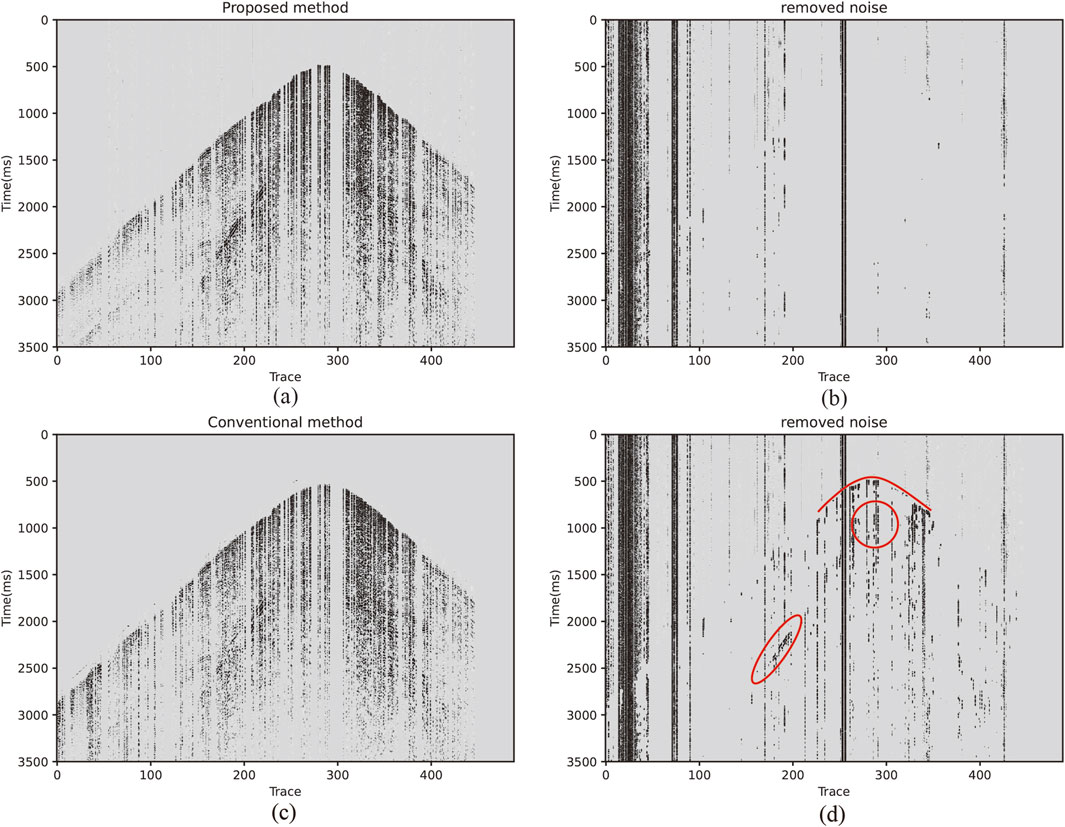
Figure 7. Attenuation of anomalous amplitude noise. (a,b) Show the valid seismic data and the removed noise using the joint method, respectively. (c,d) Show the results using the conventional method (WST).
4 Discussion
4.1 The impact of incorrect noise identification
In practical processing, picking the first-break is a very cumbersome procedure, despite the availability of various algorithms (Guo et al., 2021; Huynh et al., 2023). If we could attenuate these anomalous noises before picking the first-break, the picking algorithm would work better owing to the absence of noise. The joint method is less dependent on the precise first-breaks. In the above examples, satisfactory results were achieved using the assumption of theoretical first-break which can be calculated automatically. Therefore, with the joint method, we can first remove noise using theoretical first-breaks, and then apply certain an automatic algorithm (Huynh et al., 2023) for picking accurate first-breaks.
For the data below the first-break, the individual or local CtoN will not influence the denoising results. Figure 8 shows an example of the CtoN. The black bars marked the seismic signals which are incorrectly identified as noises. Note that the amplitude analysis marks the entire traces, while the deep learning marks the local samples. As shown in the raw seismic data (Figure 8b), these marked signals do not belong to anomalous noises. After processing with the joint method, the denoised seismic data in Figure 8c is the same as the raw data in Figure 8b. This shows that these CtoN traces will not be attenuated. This is primarily attributed to the utilization of the PAT method, which ensures a minimal difference between the reference and effective amplitude.

Figure 8. Noise attenuation in CtoN scenarios: (a) The identified noises, (b) the raw seismic data, and (c) the denoised seismic data.
The advantage of the PAT method for computing the reference amplitude lies in its ability to achieve higher robustness. If we use the WST method to calculate the reference amplitude, such reference amplitude may not be accurate, so the amplitude of the CtoN sample may exceed the inaccurate threshold, resulting in the attenuation of valid seismic signals. In contrast, the reference amplitude determined by the PAT method will be more accurate. The amplitude of the CtoN sample does not exceed the accurate threshold; therefore, such a sample will not be attenuated. In addition, we added the judgment conditions based on the noise identification results when calculating the attenuation coefficient. This makes the overall noise attenuation method more stable. In the presence of continuous CtoN traces, the accuracy of the threshold will decrease. Fortunately, the case is rare when continuous anomalous noise only occurs in pure environment recordings and is absent in the seismic recordings.
4.2 The comparison with pure deep learning
Li et al. (2024) constructed a pure deep learning method to suppress abnormal environmental noise utilizing the characteristics of the data collected by the nodal instrument. Li et al. (2024) quantitatively analyzed the effects of deep learning denoising using field land seismic data with added noise, the Poland 2D Vibroseis Line 001, provided by Geofizyka Torun S.A. from the SEG wiki website. We use the same data to compare the joint method and pure deep learning method proposed by Li et al. (2024). Appendix A in Li et al. (2024) gives a detailed flow of making data with added noise. Figures 9–11 show the denoising effect of the conventional method, pure deep learning (Li et al., 2024), and the proposed joint method, respectively. Overall, the denoising effects of pure deep learning (Li et al., 2024) and the joint method are comparable. Examining the red circle area in Figures 9–11, it is situated near the source point and exhibits strong energy. The three methods show diverse denoising effects in this region. The conventional method identifies this area as noise, resulting in the attenuation of its energy. Deep learning removes some effective signals. Conversely, the joint method causes minimal damage to effective signals. By testing field data with adding noise, the joint method has a better and more stable noise attenuation effect when the noise content is higher.
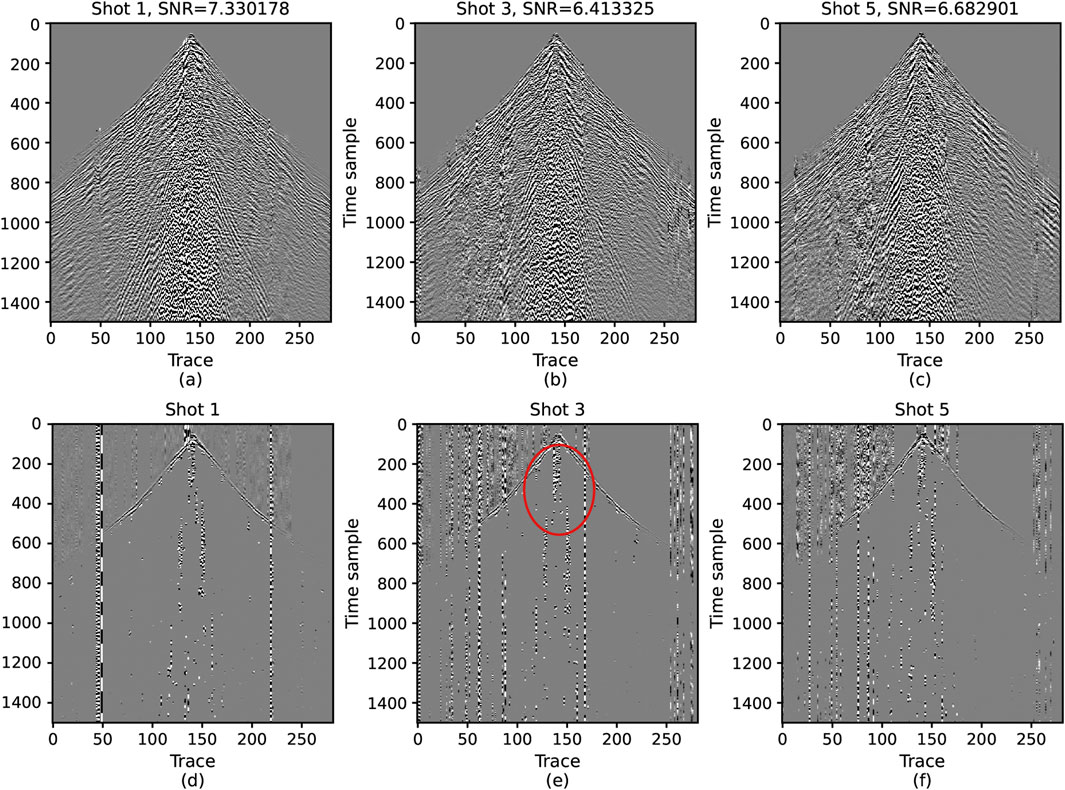
Figure 9. The results of shots 1, 3, and 5 using the conventional method. (a–c) are the denoised data. (d–f) are the removed noise.
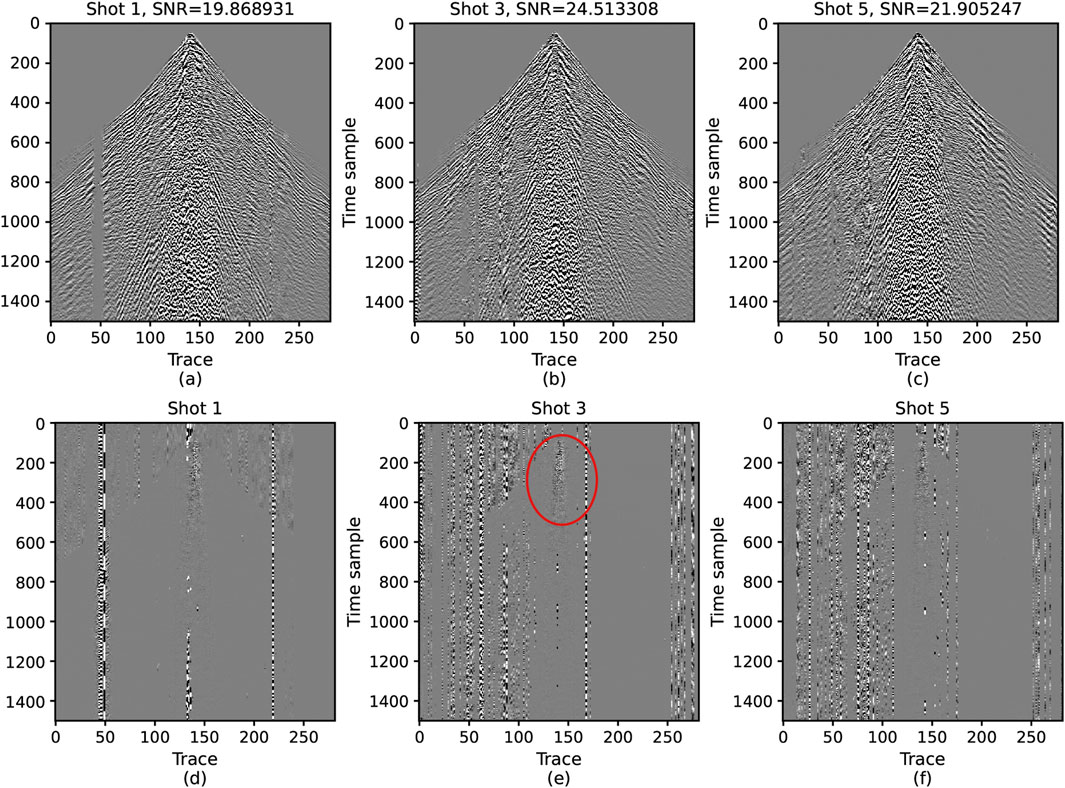
Figure 10. The results of shots 1, 3, and 5 using deep learning (Li et al., 2024). (a–c) are the denoised data. (d–f) are the removed noise.
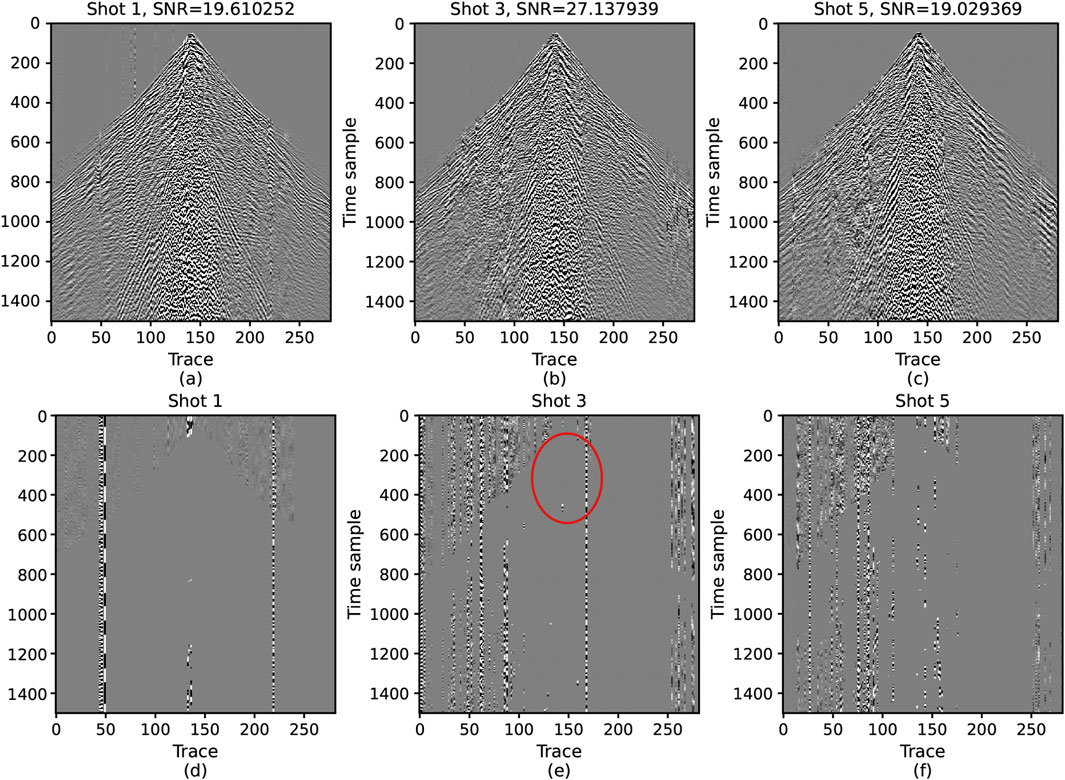
Figure 11. The results of shots 1, 3, and 5 using the joint method. (a–c) are the denoised data. (d–f) are the removed noise.
4.3 Processing methods for wired data collection
Pure background noise is consistently present between the shooting time and the first-breaks. Therefore, the joint method can also be applied to cable acquisition data to a certain extent. However, in near offset traces, noise identification can become less accurate due to insufficient pure noise records. In this case, a common receiver gather can be utilized for noise identification. The spatial positions of the receivers and certain sources of anomalous noise, such as factories, highways, etc., remain unchanged. Therefore, employing environmental records contained in the far offset traces in a common receiver gather to aid in identifying the presence of noise is reasonable. Consequently, the joint method remains applicable to conventional cable acquisition data. However, it is more suitable for data acquired by nodal instruments.
5 Conclusion
Leveraging the continuous data acquisition feature of the node instrument and the pure noise recordings captured prior to the shooting time, we propose a method for joint identification and attenuation of anomalous noise, which offers both high flexibility and practicality. On the basis of identifying noise, we constructed the PAT method to calculate the threshold. The joint method preserves strong amplitudes associated with non-anomalous noise sources, such as surface waves and near-offset traces. In addition, the joint method shows high robustness and tolerance for errors in noise identification. Inaccurate first-breaks and local misidentifications have little impact on the final noise attenuation outcome. Compared to the conventional method and pure deep learning method, the joint method exhibits significant advantages in preserving effective seismic signals. Moreover, these pure environmental recordings are often discarded during data acquisition. We utilize these discarded data to implement a more stable and effective denoising method of anomalous noise.
Data availability statement
The raw data supporting the conclusions of this article will be made available by the authors, without undue reservation.
Author contributions
XM: Supervision, Writing – original draft, Conceptualization. WY: Formal Analysis, Methodology, Writing – original draft, Writing – review and editing, Visualization. ZP: Investigation, Validation, Writing – review and editing. QZ: Writing – review and editing, Validation, Investigation. HM: Validation, Writing – review and editing. DZ: Writing – review and editing, Conceptualization, Supervision. XW: Writing – review and editing, Project administration. LP: Validation, Writing – review and editing.
Funding
The author(s) declare that financial support was received for the research and/or publication of this article. This research was funded by China National Petroleum Corporation (CNPC) under the major project ‘Research on Exploration and Development of Ultra-Deep Clastic Oil and Gas Storage Enhancement and Production Increase’ (grant no. 2023ZZ14YJ).
Acknowledgments
The authors sincerely appreciate Xiaobin Li for their constructive suggestions and thoughtful discussions, and gratefully acknowledge the two reviewers for their insightful comments, all of which have significantly improved the manuscript.
Conflict of interest
Authors XM, ZP, HM, XW, and LP were employed by PetroChina Xinjiang Oilfield Company.
Authors WY and QZ were employed by BGP Inc. China National Petroleum Co.
Author DZ was employed by PetroChina Southwest Oil & Gas Field Company.
The authors declare that this study received funding from China National Petroleum Corporation (CNPC). The funder had the following involvement in the study: study design, data collection, and analysis.
Generative AI statement
The author(s) declare that no Generative AI was used in the creation of this manuscript.
Publisher’s note
All claims expressed in this article are solely those of the authors and do not necessarily represent those of their affiliated organizations, or those of the publisher, the editors and the reviewers. Any product that may be evaluated in this article, or claim that may be made by its manufacturer, is not guaranteed or endorsed by the publisher.
References
Anderson, R. G., and McMechan, G. A. (1989). Automatic editing of noisy seismic Data1. Geophys. Prospect. 37, 875–892. doi:10.1111/j.1365-2478.1989.tb02238.x
Bekara, M., Ferreira, A., and van der Baan, M. (2008). “A statistical technique for high amplitude noise detection: application to swell noise attenuation,” in SEG Technical Program Expanded Abstracts 2008, Society of Exploration Geophysicists, 2601–2605.
Bekara, M., and van der Baan, M. (2010). High-amplitude noise detection by the expectation-maximization algorithm with application to swell-noise attenuation. Geophysics 75, V39–V49. doi:10.1190/1.3428749
Dean, T., Tulett, J., and Barnwell, R. (2018). Nodal land seismic acquisition: the next generation. First Break 36, 47–52. doi:10.3997/1365-2397.n0061
Dong, X., Lin, J., Lu, S., Huang, X., Wang, H., and Li, Y. (2022). Seismic shot gather denoising by using a supervised-deep-learning method with weak dependence on real noise data: a solution to the lack of real noise data. Surv. Geophys. 43, 1363–1394. doi:10.1007/s10712-022-09702-7
Guo, C., Zhu, T., Gao, Y., Wu, S., and Sun, J. (2021). AEnet: automatic picking of P-wave first arrivals using deep learning. IEEE Trans. Geosci. Remote Sens. 59, 5293–5303. doi:10.1109/tgrs.2020.3010541
Guo, J., and Lin, D. (2003). “High amplitude noise attenuation,” in SEG Technical Program Expanded Abstracts 2003, Society of Exploration Geophysicists, 1893–1896.
Hu, C., and Lu, W. (2014). A hybrid method for strong low-frequency noise suppression in prestack seismic data. J. Appl. Geophys. 108, 78–89. doi:10.1016/j.jappgeo.2014.06.014
Huynh, N. N. T., Martin, R., Oberlin, T., and Plazolles, B. (2023). Near-surface seismic arrival time picking with transfer and semi-supervised learning. Surv. Geophys. 44, 1837–1861. doi:10.1007/s10712-023-09783-y
Jin, W., Zhu, F., Lv, X., Feng, X., Shi, Y., and Dai, W. (2021). Discussion on field processing and monitoring of seismic data collected by a nodal seismic acquisition system: a case study in CLFCZ3D work area. Geophys. Prospect. Petroleum 60, 18–26. doi:10.3969/j.issn.1000-1441.2021.S1.004
Jun, P., Xi-Wu, L., Hong, L., and Zhong-Hui, Y. (2016). Application of anomalous amplitude noise attenuation in seismic data processing of multichannel survey line. Prog. Geophys. 31, 1639–1645.
Kingma, D. P., and Ba, J. (2015). “Adam: a method for stochastic optimization,” in Proceedings of the 3rd International Conference on Learning Representations (ICLR 2015).
Li, X., Qi, Q., Yang, Y., Duan, P., and Cao, Z. (2024). Removing abnormal environmental noise in nodal land seismic data using deep learning. Geophysics 89, WA143–WA156. doi:10.1190/geo2023-0143.1
Liu, L., and Ma, J. (2023). DL2: dictionary learning regularized with deep learning prior for simultaneous denoising and interpolation. Geophysics 88, WA13–WA25. doi:10.1190/geo2021-0838.1
Liu, Y., Liu, C., and Wang, D. (2009). A 1D time-varying median filter for seismic random, spike-like noise elimination. Geophysics 74, V17–V24. doi:10.1190/1.3043446
Srivastava, N., Hinton, G., Krizhevsky, A., Sutskever, I., and Salakhutdinov, R. (2014). Dropout: a simple way to prevent neural networks from overfitting. J. Mach. Learn. Res. 15, 1929–1958.
Tian, X., Lu, W., and Li, Y. (2022). Improved anomalous amplitude attenuation method based on deep neural networks. IEEE Trans. Geosci. Remote Sens. 60, 1–11. doi:10.1109/tgrs.2021.3052898
Tian, X. Y., and Lu, W. K. (2021). An adaptive anomalous amplitude attenuation method based on deep. Neural Netw. 2021, 1–5.
Wu, X., Yuan, Y., and Li, H. (2017). “Anomalous amplitudes attenuation based on the seismic wave propagation theory,” in International Geophysical Conference, Qingdao, China, 17-20 April 2017 (Tulsa, Oklahoma, USA: SEG Global Meeting AbstractsSociety of Exploration Geophysicists and Chinese Petroleum Society), 365–368.
Yang, L., Wang, S., Chen, X., Saad, O. M., Chen, W., Oboué, Y., et al. (2022). Unsupervised 3-D random noise attenuation using deep skip autoencoder. IEEE Trans. Geosci. Remote Sens. 60, 1–16. doi:10.1109/tgrs.2021.3100455
Yang, L., Wang, S., Chen, X., Saad, O. M., Cheng, W., and Chen, Y. (2023). Deep learning with fully convolutional and dense connection framework for ground roll attenuation. Surv. Geophys. 44, 1919–1952. doi:10.1007/s10712-023-09779-8
Yu, S., Ma, J., and Wang, W. (2019). Deep learning for denoising. Geophysics 84, V333–V350. doi:10.1190/geo2018-0668.1
Yuan, Y., Si, X., and Zheng, Y. (2020). Ground-roll attenuation using generative adversarial networks. Geophysics 85, WA255–WA267. doi:10.1190/geo2019-0414.1
Keywords: anomalous amplitude noises, attenuation, nodal land seismic data, denoising, deep learning
Citation: Mao X, Yang W, Pang Z, Zhou Q, Mao H, Zhang D, Wang X and Pan L (2025) Combined identification and attenuation of anomalous amplitude noises in nodal land seismic data. Front. Earth Sci. 13:1535990. doi: 10.3389/feart.2025.1535990
Received: 28 November 2024; Accepted: 08 April 2025;
Published: 02 May 2025.
Edited by:
Jidong Yang, China University of Petroleum (East China), ChinaCopyright © 2025 Mao, Yang, Pang, Zhou, Mao, Zhang, Wang and Pan. This is an open-access article distributed under the terms of the Creative Commons Attribution License (CC BY). The use, distribution or reproduction in other forums is permitted, provided the original author(s) and the copyright owner(s) are credited and that the original publication in this journal is cited, in accordance with accepted academic practice. No use, distribution or reproduction is permitted which does not comply with these terms.
*Correspondence: Wen Yang, eWFuZ3dlbjAzQGNucGMuY29tLmNu
 Xinjun Mao1
Xinjun Mao1 Wen Yang
Wen Yang